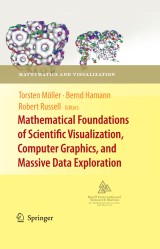Details

Mathematical Foundations of Scientific Visualization, Computer Graphics, and Massive Data Exploration
Mathematics and Visualization
|
CHF 118.00 |
|
| Verlag: | Springer |
| Format: | |
| Veröffentl.: | 12.06.2009 |
| ISBN/EAN: | 9783540499268 |
| Sprache: | englisch |
| Anzahl Seiten: | 350 |
Dieses eBook enthält ein Wasserzeichen.
Beschreibungen
The goal of visualization is the accurate, interactive, and intuitive presentation of data. Complex numerical simulations, high-resolution imaging devices and incre- ingly common environment-embedded sensors are the primary generators of m- sive data sets. Being able to derive scienti?c insight from data increasingly depends on having mathematical and perceptual models to provide the necessary foundation for effective data analysis and comprehension. The peer-reviewed state-of-the-art research papers included in this book focus on continuous data models, such as is common in medical imaging or computational modeling. From the viewpoint of a visualization scientist, we typically collaborate with an application scientist or engineer who needs to visually explore or study an object which is given by a set of sample points, which originally may or may not have been connected by a mesh. At some point, one generally employs low-order piecewise polynomial approximationsof an object, using one or several dependent functions. In order to have an understanding of a higher-dimensional geometrical “object” or function, ef?cient algorithms supporting real-time analysis and manipulation (- tation, zooming) are needed. Often, the data represents 3D or even time-varying 3D phenomena (such as medical data), and the access to different layers (slices) and structures (the underlying topology) comprising such data is needed.
Maximizing Adaptivity in Hierarchical Topological Models Using Cancellation Trees.- The TOPORRERY: computation and presentation of multi-resolution topology.- Isocontour based Visualization of Time-varying Scalar Fields.- DeBruijn Counting for Visualization Algorithms.- Topological Methods for Visualizing Vortical Flows.- Stability and Computation of Medial Axes - a State-of-the-Art Report.- Local Geodesic Parametrization: an Ant’s Perspective.- Tensor-Fields Visualization Using a Fabric-like Texture Applied to Arbitrary Two-dimensional Surfaces.- Flow Visualization via Partial Differential Equations.- Iterative Twofold Line Integral Convolution for Texture-Based Vector Field Visualization.- Constructing 3D Elliptical Gaussians for Irregular Data.- From Sphere Packing to the Theory of Optimal Lattice Sampling.- Reducing Interpolation Artifacts by Globally Fairing Contours.- Time- and Space-efficient Error Calculation for Multiresolution Direct Volume Rendering.- Massive Data Visualization: A Survey.- Compression and Occlusion Culling for Fast Isosurface Extraction from Massive Datasets.- Volume Visualization of Multiple Alignment of Large Genomic DNA.- Model-based Visualization - Computing Perceptually Optimal Visualizations.
<P>Visualization is one of the most active and exciting areas of Mathematics and Computing Science, and indeed one which is only beginning to mature. Current visualization algorithms break down for very large data sets. While present approaches use multi-resolution ideas, future data sizes will not be handled that way. New algorithms based on sophisticated mathematical modeling techniques must be devised which will permit the extraction of high-level topological structures that can be visualized.</P>
<P></P>
<P>For these reasons a workshop was organized at the Banff International Research Station, focused specifically on mathematical issues. A primary objective of the workshop was to gather together a diverse set of researchers in the mathematical areas relevant to the recent advances in order to discuss the research challenges facing this field in the next several years. The workshop was organized into five different thrusts:</P>
<P></P>
<P>- Topology and Discrete Methods</P>
<P>- Signal and Geometry Processing</P>
<P>- Partial Differential Equations</P>
<P>- Data Approximation Techniques</P>
<P>- Massive Data Applications</P>
<P></P>
<P>This book presents a summary of the research ideas presented at this workshop.</P>
<P></P>
<P>For these reasons a workshop was organized at the Banff International Research Station, focused specifically on mathematical issues. A primary objective of the workshop was to gather together a diverse set of researchers in the mathematical areas relevant to the recent advances in order to discuss the research challenges facing this field in the next several years. The workshop was organized into five different thrusts:</P>
<P></P>
<P>- Topology and Discrete Methods</P>
<P>- Signal and Geometry Processing</P>
<P>- Partial Differential Equations</P>
<P>- Data Approximation Techniques</P>
<P>- Massive Data Applications</P>
<P></P>
<P>This book presents a summary of the research ideas presented at this workshop.</P>
Cutting-edge research in a fast-moving cross-disciplinary field touching visualization, computer graphics, and CSE Includes supplementary material: sn.pub/extras
Diese Produkte könnten Sie auch interessieren:

Mixed-Signal Layout Generation Concepts

von: Chieh Lin, Arthur H.M. van Roermund, Domine Leenaerts

CHF 118.00

System-Level Design Techniques for Energy-Efficient Embedded Systems

von: Marcus T. Schmitz, Bashir M. Al-Hashimi, Petru Eles

CHF 118.00














